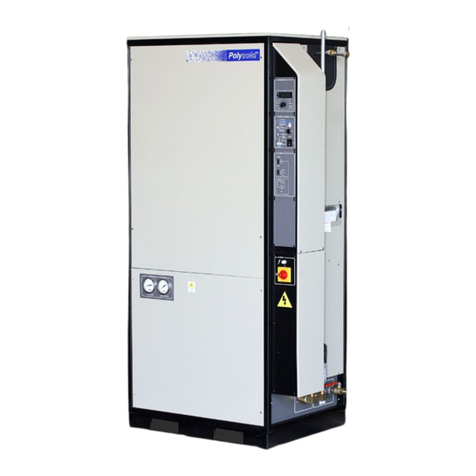
2 Copyright 2007, Brooks Automation Part Number 8040706, Revision 1, 12/13/2007 ECO Number 18207 Printed in U.S.A 3
Before You Start
1. Ensure 8600 Compressors are installed according to 8040705, Cryo-Torr 8600 Compressor Quick Installation
Guide and 8040707, Cryo-Torr 8600 Compressor Operation, Installation, and Maintenance Manual.
2. Read and follow all safety notices in this guide and in the appropriate compressor guides.
Cryopump Safety
Ensure the cryopump operates safely and dependably by adhering to all safety notices when you use or service the
cryopump.
NOTE: To avoid loss of helium, do not modify or remove the pressure relief valves.
Always connect and disconnect helium flex lines with the method illustrated in Figure 1 Inset B.
Cryopump Connections
See the following numbered steps in Figure 1 for cryopump installation connections.
NOTE: Before mounting the cryopump to the vacuum system, ensure a high-vacuum isolation (hi-vac) valve is installed
between the cryopump and the vacuum chamber. This isolates the cryopump from the chamber during rough
pumping, cooldown, and regeneration.
NOTE: Install the cryopump in any orientation. This does not affect its performance.
Figure 1: 8F Cryopump Basic Connections
Startup the Cryopump
See the 8040613, Cryo-Torr High-Vacuum Pump Installation, Operation, and Maintenance Instructions, for details.
Product Information and Technical Support
Please
visit
the
Brooks
Automation website at www.brooks.com or email to [email protected].
Toxic, Corrosive, Flammable or Explosive Materials
1. To prevent personal injury, over pressurization, and equipment damage, always vent
toxic, corrosive, or flammable materials to a safe location using an inert gas.
2. Clearly identify toxic, corrosive, or flammable materials on shipping containers when you
ship equipment that contacted these materials.
3. To prevent flammable gas ignition, do not install a hot filament type vacuum gauge on the
high vacuum side of the isolation valve.
4. To prevent explosions, be aware of ozone as a by-product of an oxygen process, and
take the appropriate precautions.
High Voltage Electric Shock Hazard
1. To avoid electric shock, disconnect the cryopump from all power sources before making
electrical connections between system components, and before performing
troubleshooting or maintenance procedures.
2. When you connect the cryopump to a power source, ensure it is a 208 VAC, Single-
Phase 5 Amp source.
Heavy Object
To avoid injury when moving the cryopump, use a lifting aid and proper lifting techniques.
High Pressure Gas Hazard
To avoid injury from unexpectedly propelled objects, always bleed the helium charge to
atmospheric pressure before servicing or disassembling the self-sealing couplings.
Remove flange cover (not visible), and
clean o-ring and flange.
Attach flange (ANSII shown) to hi-vac
valve on tool with mounting bolts.
Connect Relief Valve Exhaust (Figure 1
Inset A).
Connect rough pump.
Connect purge gas supply.
Remove dust cap and connect (tighten)
helium supply line (Figure 1 Inset B).
Remove dust cap and connect (tighten)
helium return line (Figure 1 Inset B).
Connect temperature sensor cable (not
visible).
Connect motor cable.
1
2
3
4
5
6
7
8
2
6
7
9
5
TO TIGHTEN
TO LOOSEN
Turn with 3/16 inch wrench
Hold with 1 inch wrench
Hold with 1 1/8 inch wrench
Turn with 1 3/16 inch wrench
Figure 1 Inset B: Helium Flex Line Connections
4
3
9
1/2 INCH X 14 NPTF
TUBE ADAPTER
1/2 INCH VENT LINE
EXHAUST
GAS
ADAPTER
CUSTOMER SUPPLIED
Figure 1 Inset A: Relief Valve Exhaust Connection
1




















